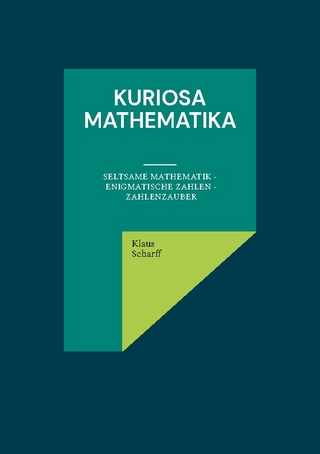
Pisot and Salem Numbers
Springer Basel (Verlag)
978-3-0348-9706-8 (ISBN)
1 Rational series.- 1.1 Algebraic criteria of rationality.- 1.2 Criteria of rationality in C.- 1.3 Generalized Fatou's lemma.- Notes.- References.- 2 Compact families of rational functions.- 2.1 Properties of formal series with rational coefficients.- 2.2 Compact families of rational functions.- Notes.- References.- 3 Meromorphic functions on D(0,1). Generalized Schur algorithm.- 3.0 Notation.- 3.1 Properties of Schur's determinants.- 3.2 Characterization of functions belonging to M.- 3.3 Generalized Schur algorithm.- 3.4 Characterization of certain meromorphic functions on D(0,1).- 3.5 Smyth's theorem.- Notes.- References.- 4 Generalities concerning distribution modulo 1 of real sequences.- 4.0 Notation and examples.- 4.1 Sequences with finitely many limit points modulo 1.- 4.2 Uniform distribution of sequences.- 4.3 Weyl's theorems.- 4.4 Van der Corput's and Fejer's theorems. Applications.- 4.5 Koksma's theorem.- 4.6 Some notions about uniform distribution modulo 1 in Rp.- Notes.- References.- 5 Pisot numbers, Salem numbers and distribution modulo 1.- 5.0 Notation.- 5.1 Some sequences (??n) non-uniformly distributed modulo 1.- 5.2 Pisot numbers and Salem numbers. Definitions and algebraic properties.- 5.3 Distribution modulo 1 of the sequences (?n) with ? a U-number.- 5.4 Pisot numbers and distribution modulo 1 of certain sequences (??n).- 5.5 Salem numbers and distribution modulo 1 of certain sequences (??n).- 5.6 Sequences (??n) non-uniformly distributed modulo 1.- Notes.- References.- 6 Limit points of Pisot and Salem sets.- 6.0 Notation.- 6.1 Closure of the set S.- 6.2 The derived set S? of S.- 6.3 Successive derived sets of S.- 6.4 Limit points of the set T.- Notes.- References.- 7 Small Pisot numbers.- 7.1 Schur's approximations forelements of N*1.- 7.2 Small Pisot numbers.- 7.3 The smallest number of S?.- Notes.- References.- 8 Some properties and applications of Pisot numbers.- 8.1 Some algebraic properties and applications of Pisot and Salem numbers.- 8.2 An application of Pisot numbers to a problem of uniform distribution.- 8.3 Application of Pisot numbers to a problem of rational approximations of algebraic numbers.- 8.4 Pisot numbers and the Jacobi-Perron algorithm.- Notes.- References.- 9 Algebraic number sets.- 9.1 Sq sets.- 9.2 n-tuples of algebraic numbers.- Notes.- References.- 10 Rational functions over rings of adeles.- 10.1 Adeles of Q.- 10.2 Analytic functions in Cp.- 10.3 Rationality criteria in QI[[X]].- 10.4 Compact families of rational functions.- Notes.- References.- 11 Generalizations of Pisot and Salem numbers to adeles.- 11.1 Definition of the set UI.- 11.2 Subsets of UI and characterizations.- 11.3 The sets SI?.- 11.4 The sets TI.- 11.5 The sets SIJ.- 11.6 The sets BI.- 11.7 Closed subsets of SI?.- 11.8 Limit points of the sets TI.- Notes.- References.- 12 Pisot elements in a field of formal power series.- 12.0 Generalities and notation.- 12.1 Definitions of the sets U and S.- 12.2 Characterizations of the sets U and S.- 12.3 Limit points of the sets U and S.- 12.4 Relation between the sets S and S.- Notes.- References.- 13 Pisot sequences, Boyd sequences and linear recurrence.- 13.0 Convergence theorems.- 13.1 Pisot sequences.- 13.2 Linear recurrence and Pisot sequences.- 13.3 Boyd sequences.- Notes.- References.- 14 Generalizations of Pisot and Boyd sequences.- 14.1 Convergence theorems in AI.- 14.2 Pisot sequences in AI.- 14.3 Boyd sequences in AI.- 14.4 Pisot and Boyd sequences in a field of formal power series.- Notes.- References.- l5 The Salem-Zygmundtheorem.- 15.1 Introduction.- 15.2 Sets of uniqueness.- 15.3 Symmetric perfect sets.- 15.4 The sufficient condition for the Salem-Zygmund theorem.- 15.5 A theorem by Senge and Strauss.- References.
| Erscheint lt. Verlag | 5.11.2012 |
|---|---|
| Zusatzinfo | XIII, 291 p. |
| Verlagsort | Basel |
| Sprache | englisch |
| Maße | 170 x 244 mm |
| Gewicht | 540 g |
| Themenwelt | Mathematik / Informatik ► Mathematik ► Arithmetik / Zahlentheorie |
| Mathematik / Informatik ► Mathematik ► Wahrscheinlichkeit / Kombinatorik | |
| Schlagworte | Algebra • Calculus • ergodic theory • Mathematica • Mathematics |
| ISBN-10 | 3-0348-9706-5 / 3034897065 |
| ISBN-13 | 978-3-0348-9706-8 / 9783034897068 |
| Zustand | Neuware |
| Informationen gemäß Produktsicherheitsverordnung (GPSR) | |
| Haben Sie eine Frage zum Produkt? |
aus dem Bereich


